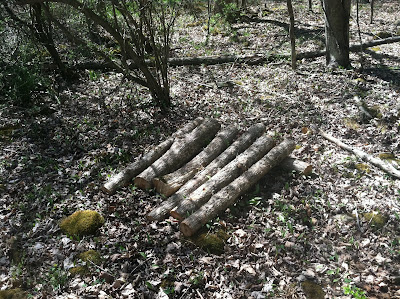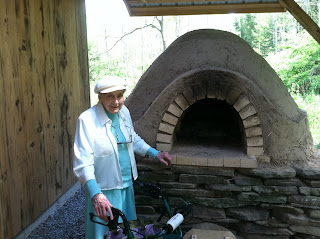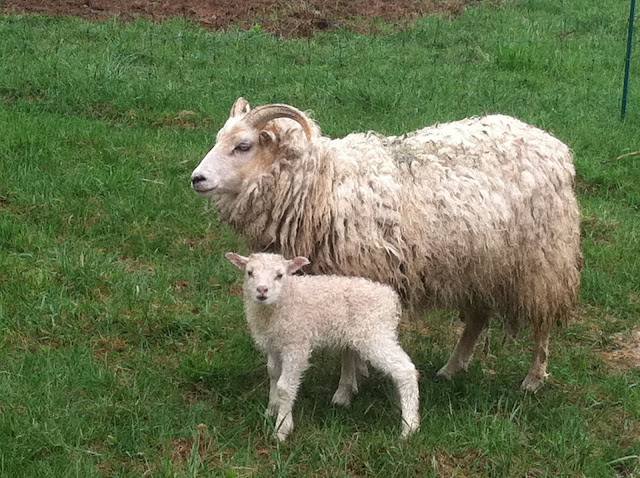The first ten days of May saw stellar weather and some significant milestones for the farm. The late April loss of two newborn lambs and one stillbirth were offset by three successful birthings - a black ewe lamb and white ram w/ brown spots to Elska, and a white ram lamb for Opala. Mothers and babies are doing just fine, and we have now successfully moved the entire flock across the road to their summer pasture area.
We will be moving the flock within a portable electric fence every ten days because the barber pole worm parasite requires ten days from when a sheep defecates until the worms can hatch out from the eggs within the fecal matter. By moving the sheep it breaks the cycle and maintains a manageable and healthy parasite load within the sheep's digestive tract.
Here's an interesting video shot by Al as he encouraged the sheep to cross the road in front of him (thanks to our neighbors Heidi Masucci and Katelyn Thompson for assisting with the moving of the sheep):

For some true relaxation on the farm - turn up your volume, expand your screen view and for a minute and a half let the stress of the day slip away as you watch our flock graze while you listen to the red wing black birds and the Dyberry Creek in the background - it's very therapeutic:
http://www.youtube.com/edit?ns=1&video_id=ENlPu3ehZJg
We are now able to cut our pastures that were recently limed to raise pH and free up minerals for the grass (and subsequently our sheep) as we recently acquired a used "Big Bee" brush hog (made in Alabama). Here you can see Dave coming down the road on our 195? Ferguson T035 tractor (love that sound :)
http://www.youtube.com/watch?v=qwaB9F1JAXQ&feature=youtu.be
The big project thus far this month has been the installation of the frame for our 96' x 28' high tunnel that was a grant from the USDA and will be used for crop season extension in both early spring and late fall/winter. This project has been quite an undertaking for Dave and Al. Special thanks go out to the guys from the nearby Ant Hill Farm - Sam, Ben, and Derek for their much needed help and to Ant Hill Farm owner, Sky Ballantine for allowing his crew to spend some time with us. More than two pairs of hands make some parts of this installation much easier.

Next up are the plexiglass end walls, and finally the poly cover. The house will have roll up sides and large doors on each end for venting in the summertime. We purchased the high tunnel kit from H. Schwartz & Sons in Wilmington, DE and have been pleased with the quality of the steel and with working with this family owned business.
Water is going to be critical for inside the high
tunnel, so to improve output from our solar powered watering system, Dave recently moved the pump house, solar panel, and intake pipe much closer the small spring fed stream we are using as our water source. Since the distance from the intake pipe to the pump was greatly reduced, we seem to be getting a lot more water flow/pressure to our soaker hoses when the sun is shining. Next step is to add a drip/soaker line and control valve for each row in the garden.
The wagon is almost complete. It is a gem. With help from our friend and neighbor, Ron Otto, we re-welded some of the frame, and then Dave built the entire wagon out of "green" hemlock. The "running gear" or chassis was also re-worked and wheel bearings repacked. Used truck tires were added and the wheels re-painted. All she needs now are some summer campers that will be arriving come June for farm adventure retreats. We will also be adding a back tailgate/step of some sort that will allow for easy on/off access.
Speaking of farm tours, our first workshop/farm tour/earthen oven pizza baking event has been postponed from May until Sunday, Sept. 29th. Please visit: http://store.mossacres.com/category_s/1941.htm for more details or to sign up.
Early season crop planting has also been going on in ernest. "Purple Viking", "Butte" Russet, and

"Katahdin" potatoes have been planted. Snap peas, carrots, and our signature "Grax" giant beets have also gone in, as have various onion set varieties. Parsnips round out our current planting list. June 10th or so marks the last frost date in our chilly valley, so we need to wait on some of the warmer season veggies. We also brought in additional compost from a local compost supplier and have been spreading that into each unplanted row and tilling it in with the help of Roger Hill and his Kubota tractor.

Rubarb harvesting has been taking place from
the plants given to the farm by neighbor Jim Sanders. The are growing like weeds.

Speaking of weeds...
Wild Food Alert: Wild mustard greens. Al's wife Deena's favorite are just now winding down upstate. We find them to be best sauteed slowly for several minutes in olive olive with onions, lemon and salt and pepper. The much coveted fiddlehead ferns come next. Some wild leeks ("ramps") were also enjoyed, as they are very prevalent in our river valley and wooded hillsides. Dandelion greens will be experimented with as we are new to those.
Our eggs are now more delicious than ever since we moved our 27 bird flock into our orchard area where we are blessed with some incredibly lush grass. The four hen turkeys are still sitting on two large clutches of eggs. As we approach the 28 day hatching date we don't have very high expectations, as without a tom to have fertilized the eggs we will only get polts if somehow the wild gobbler that was circling our fence repeatedly got into mate with our hens when we weren't looking :)
With the chickens our results have been much
better, as to date close to twenty chicks have hatched in our incubator (in 21 days) from our fertilized eggs. The chicks are mutts for sure, crosses of some 16 possible different breed combinations. Regardless they sure are cute and very vigorous - we haven't lost one yet. We would have preferred to let the chickens go "broody" and sit on the eggs, but they weren't doing that this spring, so to continue to build our flock of egg layers we will probably rear a couple more batches in our 41 egg incubator in the coming weeks.
Numerous tree swallows and bluebirds jockey for our four nesting boxes down in the garden. The one surviving hive of bees is hard at work pollinating our lower orchard that currently has peaches, cherries, and some pears in full bloom. Our newly planted orchard in the upper pasture appears to have transplanted well. Close to 100 mushroom logs have also been inoculated and laid down in damp shady areas.

Hard cider: For those of you interested in making hard cider from Apples, Al's trial batch was a solid success. Although very much on the dry side, this first batch packs a pretty strong punch and turned out incredibly clear as it was finished off in a 1 gallon jug after coming out of the 1.5 gallon jug, and allowed to set for about five months in the basement before the final siphoning and bottling.
Until next time, enjoy all our photos below and this amazing weather we have been having - it's nice to get some extended spring weather for once instead of moving directly to summer. Heck, we might even get some fruit in the orchard this year thanks to a more normal bud break.
Your Friends at Old School Farm
 |
| Icelandic wool beginning to shed naturally |
 |
| Chicks under heat lamp in basement - hours of fun! |
 |
| One of our trails with glacial boulders blanketed in moss |
 |
| Red Trilliums |
 |
| Asparagus poking through mulch & compost |
 |
| An old horseshoe now imbedded in a beech tree |
 |
| A proud father and his son |
 |
| Uncas (he enjoys having his forehead scratched) |
 |
| Moving sawdust up to raspberry beds for mulch |
 |
| Hop Hornbeam logs inoculated with Shitake Mushroom spawn |
 |
| Getting the old piano tuned up and overhauled for the boys |
 |
| Olive Walter's daffodils live on |
 |
A push wheel seeder such as this makes planting
long rows of small seeds much easier |
 |
| Our rooster "Owen" stretches his wings. |
 |
| Setting up the portable electric fence |
 |
A zen moment for Dave while hand
planting parsnip seeds with Al |




 We fired the cob bread oven for about five hours prior to cooking, then moved the coals far to the back, leaving plenty of cooking surface on the fire bricks, onto which we slid the pies with an aluminum "peel". This was retrofitted with a long handle from a broken farm shovel (saving things on a farm is always a good idea). The personal-sized pizzas take only about three minutes to cook and are typically turned once to ensure even cooking.
We fired the cob bread oven for about five hours prior to cooking, then moved the coals far to the back, leaving plenty of cooking surface on the fire bricks, onto which we slid the pies with an aluminum "peel". This was retrofitted with a long handle from a broken farm shovel (saving things on a farm is always a good idea). The personal-sized pizzas take only about three minutes to cook and are typically turned once to ensure even cooking. 




















































